Why a Sighthound?
General Information about Sighthounds and some special Remarks about Holding and Breeding
Content
- Introduction
- Sighthounds something Special
- Peculiarities of Sighthounds
- Running is an imperative Need
- A Peculiar Species – the Sighthound-People
- Sighthounds as Training Partners
- A Sighthound is a Gift to us Humans
Introduction

Sighthounds are generally divided into European and Oriental breeds, whereby some of their breed descriptions have a reference to their origin. All sighthounds give the impression of something distinguished, as you cannot see them as often as other breeds. And actually till 19 Century they were the dogs of the Noble Society that have used them for chasing.

Sighthounds or “Hetzhunde” - as we call them in Germany because of their special kind of hunting - received the attention of the bourgeoisie in the era of industrialization first. This documented with these dogs that it could also afford to hold such a race. A sighthound requires a lot of his owner`s daily time, so that its physical condition and appearance is keeping typically. Sighthounds are like any other pet that demands special care of the people. But their actual function for which they were bred, is hunting. Since many wild animals are protected nowadays, and hunting is exclusively permitted for hunters, sighthound-owners have found an idea of a meaningful replacement: They train their dogs by racings and coursings in a fenced area. The dog is running instinctively behind a whizzing plastic scrap. These are only sporting competitions, which hound and man are enjoying together, because it is exclusively done for titles and cups. Hounds are allowed to run to their heart`s content, for which they were bred, and what their anatomy show: Long legs, deep chest, movable spine, and voluminous heart and lungs. So the sentence is right: The soul of a sighthound will run.

Sighthounds something Special
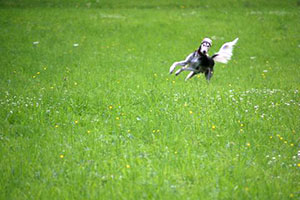
There is an overwhelming view to see a running Saluki
How did I get to like this special Breed - sighthounds? Even as a child, it should always be something special. One day I saw a Russian Hound (a Borzoi) in the neighbourhood of my grandmother, which had represented refinement and perfection by elegance and grace in his movements, he left an everlasting impression in my mind. Since then having been already impressed by a sighthound and his beauty as a child, I swore at the age of six, such a dog I want to have in some time, when I am adult. I exactly observed how this kind of dog moved. He did not trot, no - he floated. He did not grab my hand, when I gave him a little piece of my sandwich, he took it carefully out of my fingers. Also, he patiently caress, although I was only a little bit taller. It had already come through – he was a full aristocrat in his behaviour.
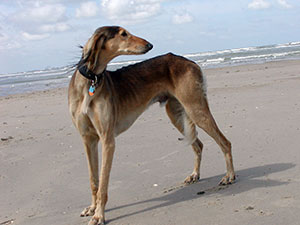
Grace and aesthetics in perfection
Many years later, as a late-68-ager, and having just passed the teacher`s exams, it should not only be an elegant and graceful dog, but also an extravagant and individualistic one at the same time, because it was the time of hippies and of the Flower Power Movement. My dog should have character and be own willed, that all I certainly wanted to concede to him. So I got my first sighthound with 25 years, a completely easy-cared dog breed, a Whippet. This small English hound breed has a very lovable character with something simpler requirements for holding. Everywhere, having appeared with such an exceptional dog, although for some people too skinny, it had drawn attention to me. Sometimes, however, also questions were to be answered, why was the dog so thin and whether he got enough to eat? No, this dog was naturally slim-lined and remained so, when he has enough movement. I was able to answer all these questions, and it was no problem to find a fitting response.
I wanted a dog, that is not slavery obedient to his master, and I had not to speak always in commands. I wanted a dog that suited me, and which is living with me as a real family member in my apartment, and that is allowed to have demands and preferences. At that time, this dog was a partner for me. Concerning the partnership, I had considerably underestimated the hound breed, because I learned to know the Orientals among the sighthounds.
Peculiarities of Sighthounds

Salukis do only hear what they want
Even my first hound, a representative of European sighthound breeds, prepared me for my later experience with oriental hounds. Later on, I have had my hands totally full with these dogs, because they do understand well to prepare their people exactly dosed for their service.
My second dog was an Arabic hound (Sloughi), when a Persian one (Saluki) followed. These dogs proved to be true soul-robbers, because they are able to teach his master, slowly and perfectly and well proportioned with all kindness that this or that they do not want or do not like to do. Finally, they have certainly coped, to go the way they wanted and to the dog's sake, they have the food in the bowl they would like to eat. If the master is not infernally careful, such a hound is quickly spoiled. There are also other breeds of the oriental hounds, namely the Azawakh and the Afghan. They are very capable dogs to get their people well educated as functioning servants. And what is really funny, these hound-people like to do it for their pets! How do these special beings cope, that the “Crown of Creation” likes to bear the drudgery of these soul-robbers? This is quite simply explained, by lowering these people to their claim but only one time.
Running is an imperative Need
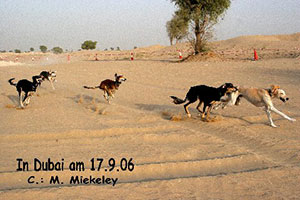
Salukis in the Desert of Dubai
Coursing and racing is a wonderful activity for sighthounds. There is nothing better than that, and these dogs can also run without a real prey. They can just run for joy. Doing this, even a large, fenced lawn will be suitable. Running is the claim that is demanded every day. Allowing my Saluki this fun, I can look into two happy dog-eyes with a smiling in his face.
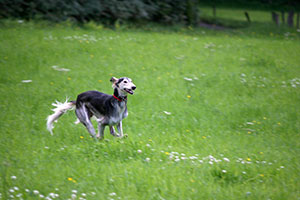
Salukis greatest activity - running
This expression in the eyes of a running Saluki reveals a passion, which must not be underestimated. A hound is born to run! If I share this love with my Saluki, then there will be a happy coexistence on both sides that leads to a long lasting friendship between dog and wo/man. And so is it - that this human is in the services of a possessed creature while practising its passion. But in this case, it is no more a fleeing hare, but a plastic part rushing-off on the racetrack. Or it is simply enjoying the movement only. Anyone who thinks the owner who keeps this dog is precisely the mirror image of this breed, is not wrong with this assumption. Sighthounds and their people are namely a peculiar species among dog keepers.
A Peculiar Species – the Sighthound-People
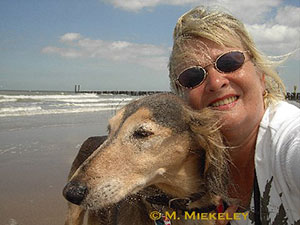
Close friendship between a Saluki and a woman
People who keep hounds are very lovable, but stubborn and freedom-loving at the same time. They do not let themselves be swayed in anything or anybody. Like their dogs: Any admission is done by pure love or affection, and never by any compulsion. These beings are sensitive and receptive to any kind and honest word. They have almost a seventh sense of truth and sincerity. Thus, step by step, a symbiosis between wo/man and dog, that becomes unique in this world, and eventually it is getting increasingly to the centre of all things, and later on it becomes the absolute satisfaction. And that's why the most people with hounds are really happy humans. If they are not, they have chosen the wrong dog breed, unfortunately, because it is not a dog for showing-off or for strolling.
Since my childhood, I am a lover of sighthounds, and since 38 years I am the owner of this Breed. I can not imagine ever to want an other breed, although I do love all dogs and appreciate them. Why? A sighthound is a contemporary, which rarely exists, yet. He has character. Such a dog is never slavishly obedient and does nothing for money. But anyone who tries to get through his will by force will either fail miserably or the character of this dog is destroyed and a pitiful creature has been left. The reason is, the once free-living hound could live without the man in the desert and helped to feed their people. Therefore, Oriental Hounds are able to arrange themselves with people and their living conditions, because they are calm and adaptedly behave themselves in the house. If they are offered enough opportunies for running, they are modest in their demands. Each day I go with my Saluki for long walks in the Sauerlands, so he is my best training partner.
Sighthounds as Training Partners
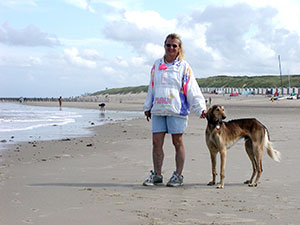
Saluki as a training partner
In the mornings, the dog can go into the garden. But soon, it will quickly be boring for him, because he already knows all the traces of scent. Therefore my Saluki is looking forward to having his daily tour in the native surroundings during the afternoon. This lasts between an hour and sometimes two hours. We dog people are happy to have a large area for dogs in the Sauerlands, which was former a military training area, and where it is possible to take walks together with many people, and to let all various breeds off the leash. There are not only dogs, but also a lot of people which spend their leisure time there. And if they do not chat and talk about dogs during these dog-walks, they collect mushrooms and pick berries. Each owner of the dogs takes part in the fate of the other one. Even young dogs learn early how to cooperate, so they are easily socialized in this way. My hound is as well known in the neighbourhood as far and wide in this terrain. Sometimes, the name of the people is not known, but certainly the name of the dog. Nobody wonders anymore, that my hound will be off the leash as often as the others of different breeds. All dogs want basically one thing: To be loved by their master and to live closely together with him. Having concerted actions, attention and affection to the dog, this partner plays an important role in the Human-Animal-Bond. My hound is allowed in a special area, but only in which I am well familiar, to be off the leash since puppy time. This is always something very special! Because the speed of such a dog in only one minute should not be underestimated, therefore each let off the leash should be always well prepared. And where is game such a dog must be on the leash in Europe, wild animals are to be protected, the dog itself and motorists. However, if someone residents like me near of a large area, or perhaps even owns a fenced lawn, will be highly rewarded for his effort and patience by the sight of a free running sighthound, which he previously had to spend before to raise such a friend.
A Sighthound is a Gift to us Humans
... and we have an obligation to treat it responsibly. We all hound fanciers have respectfully the duty to remain this gift healthy and vital, that we must together collectively ensure. Not only the keepers take over duties, for example, to provide the necessary daily running, but also the breeders. Therefore, relating to these requirements I am going to follow only a few of the desires, based on a quality management in the breeding of this wonderful Breed. I do know, of course, that these ideas cannot be realized at once, so some are to be considered as visions, but hopefully thoughts are brought in motion:
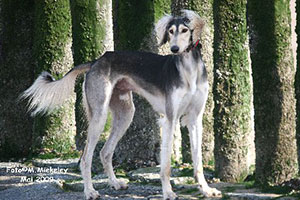
Young Saluki on the beach
Each mating must be carefully planned. The breeding animals should not be too young, and the male would only be approved for breeding of a certain number of litters. The use of so-called “Super-males” is definitely to be avoided, because such measures will constantly impoverish the gene pool of a population. It is to ensure the maintenance or restoration of genetic diversity in the dog genome, that is based on heterozygosity. This can be preserved by intervall Outcross-matings. For this reason, it is almost a necessity that breedrers work together to protect themselves against defamation, then they must not be afraid when diseases suddenly occur in a certain line. In this particular case, there is the opportunity to get help and advice from scientists to use the newest research methods (eg DNA tests). Since diseases – as well as death – belong to life, they can never be completely eradicated, but they give reason to search for helpful ways and to find meaningful activities in prevention. This must be done within the framework of health care and the aid of science and research system.
Then inquiries are to be done in pedigrees in order of tracking the succession of inheritance and locating the faulty genes, and finally to produce a marker for hereditary diseases. This will carry out new opportunities to dog breeders after a genetic test, also to plan a mating carefully with investigation. The best reward for this task will be to get a healthy offspring. But it also means, to remain a carrier of a faulty gene in the line for breeding, but under special circumstances. This is an advantage to benefit small populations. Only by these consequences it will be possible to eliminate diseases such as epilepsy, DCM, AIHA, PRA, etc. in certain lines.
In order to afford this, breeding programs must be created, based on a survey and analysis, that aimed on evaluation of effective interventions. For some hound breeds, such as Irish Wolfhounds, Whippet, Greyhounds, Salukis and Sloughis, first steps are done into this direction during breed meetings that the German Sighthound Association (DWZRV) has organized. However, it is much to be done, because the number of unreported cases of diseases will probably be high. A dog-owner will hardly talk about it, when a hound has gone young aged over the rainbow-bridge, also not to discredit the respective breeder. A breeder will hardly reveal how many dogs has suffered from a particular disease and passed away too early, especially since other breeders are not willing to do it either. Breeding hygiene and health care are an urgent necessity of hounds for the welfare of dogs, for which the breeder has once taken over an obligation to provide. Probably it may be necessary to get a different attitude to disease and research for breeders. Both should be fundamentally be changed. It can not longer be a question whether sighthounds requires research at all, or whether research will be done nationally or internationally?
Everyone who has ever been seriously ill, will understand that results of research, that are used to determine the causes of disease, must have an international attention! Therefore research has to be done in international exchange.

A happy and running Saluki
Breeders, in the Twenties of the last Century wrote articles in studbooks, and already warned strongly of inbreeding and its consequences (today known as Inbreeding Depression). These were the practical experiences, which they had done with this breeding method. Today geneticists are able to confirm these warnings, because inbreeding has a negative effect on vitality of the dogs in a long term. Nevertheless, this method is still used very often in the 21st Century, to maintain desired characteristics and to breed successful dogs. But usually this are mainly those breeders, who favour champion titles a lot. They swear on this breeding method to rise more champions (Champion or Elite breeding). But the fact is really be hidden how often they are a patient with their dogs in veterinary clinics. Even when it relates to the moderate form of line breeding, it will hurt enormously the genome structure of dogs. Nevertheless, this damage is to be seen first after some time, because of the dogs relatively long generation sequence. Prof. Hannes Lohi, University of Helsinki, warned urgently to inbreed dogs at the Seminar during the Saluki World Congress 2008, that took place in Finland. Genes of purebred dogs are becoming more homozygosity by this breeding method, that may have dramatic consequences in the Major Histocompability Complex (MHC) for the immune system of the dogs, that is responsible to prevent diseases. This part of the genome must be heterozygote, to function well and to recognize intruders in the body. Some of the breeders are even praising themselves, to use a consistent method of line breeding since many years in order to perpetuate a certain kennel type. This project can not be realized by the “one-way street” of relative matings, but better by the deliberate mating of a dam with a moderate outcross sire, to obtain or to keep the desired type. Meanwhile a champion that originated of a successful line and acquired a lot of titles in exhibition or sporting is to be found in almost all pedigrees. The consequence is there is hardly to find a dog, which is unrelated in a certain population. Particularly, this will be recognized first, if you are looking for a puppy again. Very successful dogs in show and sport will just be be mated with similar dogs (Elite Breeding). By such measures the gene pool is determined to get smaller in a population. Additionally, there is a trend to be seen to separate some hound races towards dogs for show and performance. This may not happen in any case, because form and function must be a unit in a hound! This claim can not easily realized, as we do not live in the savannah anymore, but this Breed was once bred for hunting. A focus on one orientation of the field of activity, such as the exhibition sector, can have an anatomic or behavioural change that the original function is no more possible to exercise. In addition, it is to warn about exaggerated breed characteristics, such as swan neck, dropping back line, over angled hindquarters, not typical movement, these all may interfere the actual function of sighthounds or prevent it. Judges in shows should pay attention to this misconceived interpretation of a Standard to ensure the health of hounds. Each breeding restriction, such as colours or patterns (here is to mention the set of white in the coat of Azawakhs, or the recognition of the brindle pattern in Salukis), this all may go at the expense of a gene-diversity and is leading to a continued impoverishment of necessary genes in the purebred dog genome. Also, fashion can never be a subject of dog-breeding. It is also necessary to offer sighthounds a lot of activities as a compensation for hunting. There are not only coursing, racing and exhibition, but also e.g. agility, tracking, canicross, frisbee and obedience.
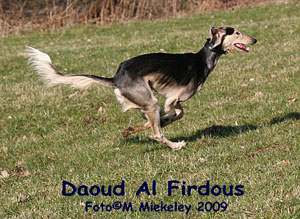
Born to run - study of a Saluki
As a biologist, who had been focussing on genetics since forty years, and who also possessing practical experience with breeding animals of different species, I have sometimes been a target of ridicule but only by those breeders, who mean practical dog breeding is something entirely different, therefore it should have its own genetic laws!
Also, it is a subject that theorists are sometimes accused by practitioners not to be competent to talk, and so criticism would be misplaced at all. These assumptions are expressed in turn by those people who have been breeding “in circles” for many years. Thus, it is simply natured, to get uncomfortable people silent, just to justify their own actions. However – a proverb says, “ignorance is bliss”.
Since my experimental breeding experience during my biology studies, especially on fish and small mammals, I have been keeping on my propagated demand no inbreeding for dogs. I do continue to appeal: Holder and breeder must work together with scientists and make blood samples available of their dogs, to know the gene structure of their breeding dogs and to identify them with the aim to be able to mate more decisively, and to reach again a larger diversity of the genes that have become homogeneous through many breeding years. Even so, it is possible that the own-body defense system is stabilized against environmental attack. Therefore it can not be sufficient, to do an Outcross mating one time, not even with a direct import from the Countries of Origin. Through a Study at the University of Helsinki it could be proved that these dogs have a greater proportion of heterozygous genes than dogs from the Western consolidated lines (see Seminar SWC; Study Prof. Hannes Lohi, University of Helsinki). Therefore, restrictive measures of breeding facilities are to be refused (eg no Imp.gen. 0 x Imp.gen. 0 mating), because import dogs from the countries of origin should be considered as an important genetic potential for a necessary “blood booster”.
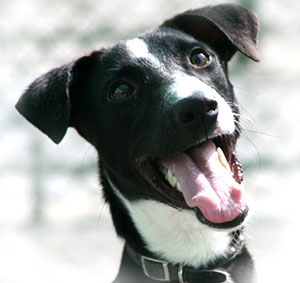
Rowdy in an animal home of Dubai
Sighthounds should remain something special. But this is only possible if they are healthy! It is an indescribably beautiful view, to see them “fly” in full gallop and in large jumps over the plane grass. I think it is a real pity, when some of them must leave us at young age because of breeding faults. Just as well it should be taken into thinking, when nearly 1500 pups are born annually in the German Sighthound Association (there are to be added the other dog breeds), because they are all looking for good homes and people who have sufficient time and knowledge to hold such an athlete in the best way. Today it is difficult to find a place where hounds have sufficient exercise in a safe terrain every day. Therefore, we people can be really happy, that sporting clubs within the Sighthound Association are offering numerous opportunities to participate adequately for training, racing and coursing. All this will be great fun for our dogs but also for the people, and everyone is satisfied again after such an active Sunday. Unfortunately, there are more and more people today, who are ready to dispose dogs like an uncomfortable thing into an animal home. Then these aristocrats land as well as any other dog there. As long as the number of born pups is higher than puppy demands, a concern still remains, where does the overproduction go? So breeding activities are to be reduced in the interest of all unborn pups. Human vanity and selfishness should be replaced with common sense for dogs wellness.
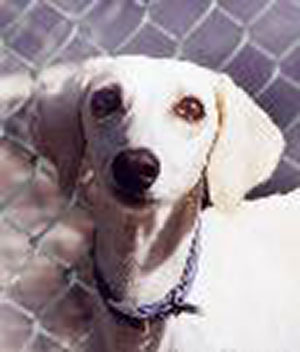
Dani in an animal home of Dubai
Similarly, I reject, when hounds are kept in kennels or cages. The number of sighthounds in the pack should remain manageable, because otherwise humans can hardly pay enough and the necessary attention to the individual.
Many years ago, I decided never to breed dogs, because I can imagine how hard it will be to give away such cute puppies, that certainly should be. Meanwhile, I am glad that I have stayed consistently in my decision, because there are really enough puppies, which are all looking for a suitable home. On websites and in dog magazines, they are offered. But dogs from aid agencies must not be forgotten. They are also looking for a new home with nice people. All this confirmed my decision, finally, not to breed dogs!
In July 2009
Dr. Margrit Miekeley
All texts and images, except otherwise noted, copyright © Dr. Margrit Miekeley

